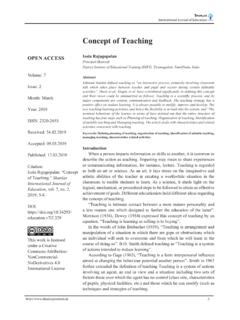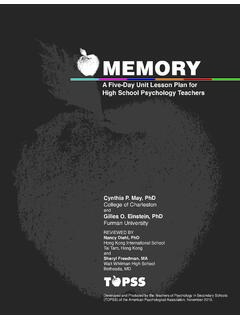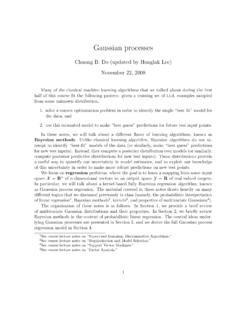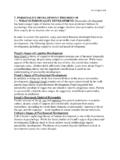Transcription of Cognitive- Behavioral Theory - SAGE Publications Inc
1 142 cognitive - Behavioral TheoryA. Antonio Gonz lez-Prendes and Stella M. ReskoCognitive- Behavioral therapy (CBT) approaches are rooted in the funda-mental principle that an individual s cognitions play a significant and primary role in the development and maintenance of emotional and behav-ioral responses to life situations. In CBT models, cognitive processes, in the form of meanings, judgments, appraisals, and assumptions associated with specific life events, are the primary determinants of one s feelings and actions in response to life events and thus either facilitate or hinder the process of adaptation.
2 CBT includes a range of approaches that have been shown to be efficacious in treating posttraumatic stress disorder (PTSD). In this chapter, we present an overview of leading cognitive - Behavioral approaches used in the treatment of PTSD. The treatment approaches discussed here include cognitive therapy/reframing, exposure therapies (prolonged exposure [PE] and virtual reality exposure [VRE]), stress inoculation training (SIT), eye movement desensitization and reprocessing (EMDR), and Briere s self-trauma model (1992, 1996, 2002).
3 In our discussion of each of these approaches, we include a description of the key assumptions that frame the particular approach and the main strategies associated with the treatment. In the final section of this chapter, we review the growing body of research that has evaluated the effectiveness of cognitive - Behavioral treatments for _____Three fundamental assumptions underscore cognitive - Behavioral models of treatment (D. Dobson & Dobson, 2009; K. Dobson & Dozois, 2001). The first assumption is that cognitive processes and content are accessible and can be known.
4 Although in many instances specific thoughts or beliefs may Chapter 2 cognitive - Behavioral Theory 15not be in one s immediate awareness, with proper training and practice indi-viduals can become aware of them. The second key assumption is that our thinking mediates the way that we respond to environmental cues. From this perspective, people do not just react emotionally or behaviorally to life events. Instead, CBT holds that the way we think about our reality is central to how we react to that reality. The third fundamental assumption of CBT is that such cognitions can be intentionally targeted, modified, and changed.
5 Consequently, when such cognitions are changed in the direction of more rational, realistic, and balanced thinking, the individual s symptoms will be relieved, and the person will have increased adaptability and functionality. This change can occur as a result of the individual s working alone, perhaps with the use of self-help material, or through engagement with a trained practitioner in one of the various CBT and PTSDT raditionally, CBT approaches to treatment of PTSD have been driven by two broad theoretical orientations that aim to explain the way fear is devel-oped and processed.
6 These orientations are learning Theory (Mowrer, 1960; Wolpe, 1990) and emotional-processing Theory (Clark & Ehlers, 2004; Ehlers & Clark, 2000; Foa & Kozak, 1986; Foa, Steketee, & Rothbaum, 1989; Hembree & Foa, 2004; Rachman, 1980).Learning TheoriesLearning theories are most often associated with Behavioral approaches that focus on modifying behavior by manipulating environmental cues ( , antecedents or reinforcers). Learning theories have focused on explaining how the mechanisms of fear and avoidance of the traumatic memory associ-ated with PTSD are conditioned, activated, and reinforced.
7 From this per-spective, unhealthy fears may develop from a single traumatic episode or from exposure to a series of unpleasant events (Wolpe, 1990). Fears can be acquired on the basis of association through classical conditioning , or they can be learned vicariously through the process of observation (Bandura, 1977, 1986). That is, a person may learn to react with fear by observing oth-ers fearful reactions to specific objects or s (1956) two-factor Theory represents one of the first attempts to provide a Behavioral explanation for the acquisition and maintenance of fear associated with PTSD (Cahill, Rothbaum, Resick, & Follette, 2009; Hembree & Foa, 2004).
8 Mowrer suggested that emotions are learned through a two-part process that includes both classical and operant conditioning . Anticipatory fear is acquired through the process of classical conditioning , and relief from this fear takes place when the danger signal is terminated through active 16 PART I THEORETICAL FRAMEWORKS avoidance of the feared object or situation, thus creating a secondary rein-forcement of the avoidance behavior ( , operant conditioning ) (Feather, 1963). In the classical conditioning model, unhealthy fear may develop when an otherwise neutral condition ( , being in an elevator) is associated with an unpleasant or dangerous outcome ( , an assault).
9 In this case the person may find himself or herself reacting to the neutral condition with the same level of fear associated with the dangerous event. Furthermore, it is possible that through the process of generalization the fear and avoidance may then expand to other places or situations that remind the individual of the trauma. These reminders or thoughts may trigger the same anticipatory fear response and engender the same avoidance behaviors associated with the original stimulus. Moreover, the avoidant behavior becomes operantly conditioned as it provides the person with relief from the unpleasant experience of fear and traditional learning theories explain the acquisition of fear and the process of avoidance seen in PTSD, these theories are criticized for falling short of explaining the full spectrum of PTSD symptoms (see Foa et al.)
10 , 1989; Hembree & Foa, 2004). Of particular note is the inability to account for generalization of fear across dissimilar situations and the failure to include thoughts, appraisals, and meaning concepts ( , dangerousness) associated with the traumatic TheoryEmotional-processing Theory (Foa & Kozak, 1986; Foa & Riggs, 1993; Rachman, 1980) provides an integrated framework to analyze and explain the onset and maintenance of PTSD. This theoretical approach combines insight from learning, cognitive , and Behavioral theories of PTSD and builds on the idea that it is not unusual for emotional experiences to continue to affect one s behaviors long after the event originally associated with the emo-tion has passed.



















